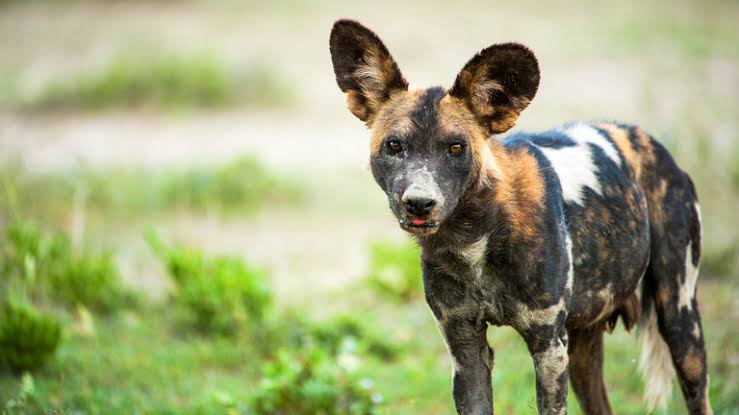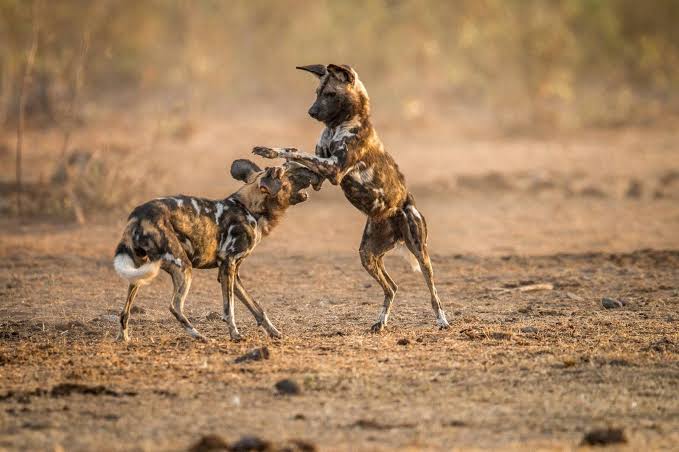What is wild dog habitat?

What is wild dog habitat?:- The African wild dog, scientifically known as Lycaon pictus, is a fascinating carnivore native to Africa. Its name means “painted wolf,” reflecting its striking coat, which is irregularly blotched with yellow, black, white, red, and brown patches. Each individual dog has a unique fur pattern, making it easy to distinguish between pack members. Unlike other members of the dog family (Canidae), African wild dogs have only four toes on each foot. This adaptation contributes to their specialized hunting abilities, along with their lean bodies, long limbs, and powerful muscles.

Physical Characteristics
African wild dogs are medium-sized, measuring about 76 to 102 centimeters (30 to 41 inches) in body length, with a tail extending an additional 31 to 41 centimeters (12 to 16 inches). They stand around 60 centimeters (24 inches) tall at the shoulder and typically weigh between 16 to 23 kilograms (35 to 50 pounds). Their large, erect ears, flat heads, and short muzzles are defining features. The large ears are not only used for hearing but also for dissipating heat, a crucial adaptation for survival in hot climates.
Despite their relatively light build, African wild dogs are incredibly effective predators, thanks to their ability to hunt in packs. Their pack cooperation and endurance make them highly successful hunters, capable of taking down prey much larger than themselves.
Hunting and Pack Life
What is wild dog habitat?:- African wild dogs are known for their extraordinary pack structure and hunting strategies. Packs typically consist of 10 to 40 individuals but can sometimes reach up to 60. The pack operates under a complex social hierarchy, with an alpha pair (the dominant male and female) leading the group. Interestingly, only the alpha pair breeds, while the rest of the pack helps raise the pups. This cooperative breeding system is a crucial survival strategy, allowing the alpha pair to focus on reproduction while the others contribute to hunting and protecting the young.
Hunting is a highly coordinated event, with each dog playing a specific role. African wild dogs are not sprinters but marathon runners. They can reach top speeds of up to 45 mph, comparable to greyhounds, but their true strength lies in endurance. During a hunt, they rely on their stamina to exhaust their prey, often running for miles until the targeted animal collapses from fatigue. Antelopes, such as impalas, are common prey, but they are also capable of taking down larger animals like wildebeests. While their hunting success rate is one of the highest among predators, their prey choices can sometimes bring them into conflict with humans, especially when they target livestock in settled areas.

Social Structure and Behaviour
What is wild dog habitat?:- The social dynamics of African wild dogs are particularly interesting. They are known for their strong social bonds, with cooperation extending far beyond hunting. Pack members share food, take care of each other’s pups, and provide care to injured or sick individuals. For example, after a successful hunt, they regurgitate food to feed not only the pups but also adults who were unable to participate in the hunt.
Pack members communicate using touch, body language, and thin, bird-like vocalizations. Every morning or after a siesta, they engage in a “meet and greet” ritual, which reinforces social bonds and prepares the pack for the next hunt. Despite their fierce hunting reputation, African wild dogs are surprisingly non-aggressive toward one another. For instance, they do not fight over food, unlike many other predators. Instead, they beg by making submissive gestures, showing their desire to eat. Adults often let younger or weaker pack members eat first, displaying a level of social cohesion rarely seen in other carnivores.
Reproduction and Care of Young
Breeding typically occurs once a year, with the alpha female giving birth to a litter of about six pups, though litters of up to 20 have been recorded. Gestation lasts between 60 and 80 days, after which the pups are born blind and helpless. African wild dogs usually give birth in abandoned aardvark or warthog burrows, where the dens provide protection from predators and harsh weather conditions. However, these dens can flood during the rainy season, posing a risk to the pups.
The entire pack contributes to raising the young. Older wild dogs help feed, protect, and even rear the pups, ensuring that the next generation of hunters thrives. This communal effort allows the alpha pair to continue hunting and leading the pack while knowing their offspring are well cared for.
Conservation Status
Sadly, African wild dogs are listed as endangered on the IUCN Red List, and their population continues to decline. As of the early 2020s, fewer than 6,000 individuals remain in the wild, scattered across southern and eastern Africa. Their decline is driven by several factors, including habitat fragmentation, human-wildlife conflict, and diseases such as rabies and distemper, which can spread from domestic dogs. In many areas, African wild dogs have disappeared altogether from their historical ranges.

The fragmentation of their habitat, particularly due to human development and agriculture, has forced these animals into smaller, isolated populations, making it harder for them to find prey and avoid human conflict. Livestock predation has led to retaliatory killings by farmers, further threatening their survival.
Conservation Efforts
Conservation organizations are working hard to protect African wild dogs and their habitats. Projects like the Okavango Wilderness Experience in Botswana aim to monitor and conserve this species by gathering data on their behavior, population dynamics, and interactions with other wildlife. Volunteers and researchers use methods like camera traps, line transects, and field surveys to collect valuable information that can inform conservation strategies.
Programs also focus on mitigating human-wildlife conflict by working with local communities to promote coexistence between wild dogs and livestock. This includes educating farmers about using predator-proof enclosures and promoting eco-tourism as a sustainable alternative to retaliatory killings.
Conclusion
In Conclusion of What is wild dog habitat, we can say The African wild dog is an extraordinary species, remarkable for its social structure, hunting prowess, and unique physical traits. However, it faces significant threats, and its future is uncertain without continued conservation efforts. Through collaborative conservation initiatives, there is hope that the African wild dog’s population can recover and that these painted wolves can continue to roam the plains of Africa for generations to come.
Also Read:-




